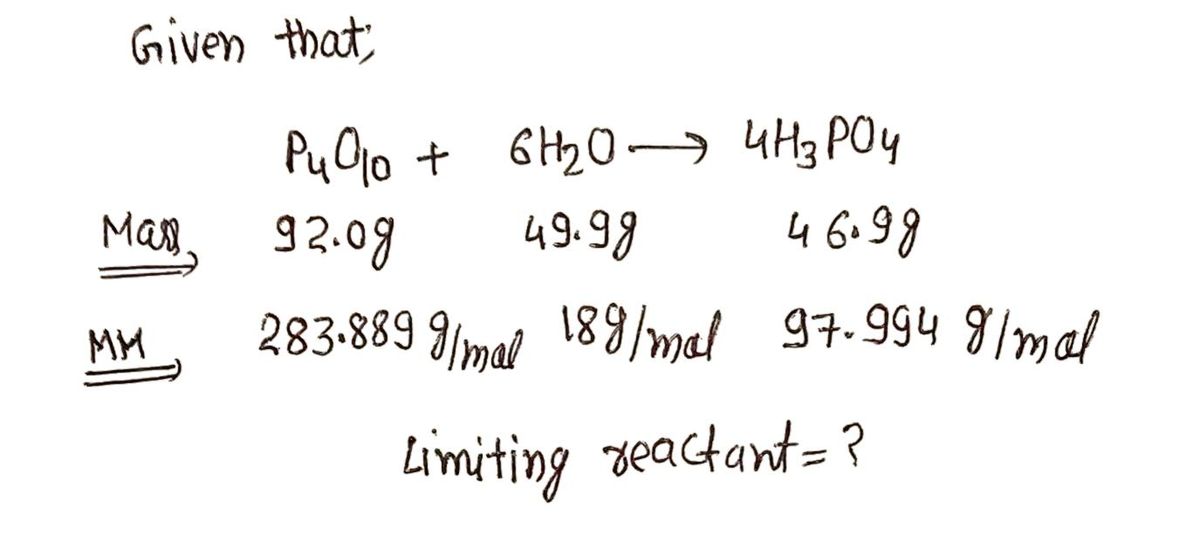Macmillan Learning A sample of 92.0 g of tetraphosphorous decoxide (P4010) reacts with 49.9 g of water to produce phosphoric acid (H₂PO4) according to the following balanced equation. P4010 + 6H₂O4 H₂PO4 Determine the limiting reactant for the reaction. OH₂PO4 OH₂O P4010 Calculate the mass of H3PO4 produced in the reaction. mass of H₂PO4: Calculate the percent yield of H3PO4 if 46.9 g of H₂PO4 is isolated after carrying out the reaction. percent yield: % g
Macmillan Learning A sample of 92.0 g of tetraphosphorous decoxide (P4010) reacts with 49.9 g of water to produce phosphoric acid (H₂PO4) according to the following balanced equation. P4010 + 6H₂O4 H₂PO4 Determine the limiting reactant for the reaction. OH₂PO4 OH₂O P4010 Calculate the mass of H3PO4 produced in the reaction. mass of H₂PO4: Calculate the percent yield of H3PO4 if 46.9 g of H₂PO4 is isolated after carrying out the reaction. percent yield: % g
Chemistry
10th Edition
ISBN:9781305957404
Author:Steven S. Zumdahl, Susan A. Zumdahl, Donald J. DeCoste
Publisher:Steven S. Zumdahl, Susan A. Zumdahl, Donald J. DeCoste
Chapter1: Chemical Foundations
Section: Chapter Questions
Problem 1RQ: Define and explain the differences between the following terms. a. law and theory b. theory and...
Related questions
Question

Transcribed Image Text:© Macmillan Learning
A sample of 92.0 g of tetraphosphorous decoxide (P4010) reacts with 49.9 g of water to produce phosphoric acid (H₂PO₂)
according to the following balanced equation.
P4010 + 6H₂O4 H₂PO4
Determine the limiting reactant for the reaction.
O H₂PO4
O H₂O
OP₂010
Calculate the mass of H3PO4 produced in the reaction.
mass of H₂PO4:
Calculate the percent yield of H3PO4 if 46.9 g of H3PO4 is isolated after carrying out the reaction.
percent yield:
Search or type URL
7
6
MacBook Pro
Y
&
N
7
U
8
+
(
9
(
0
)
0
P
+ 11
83
%
6.0
g
de
Expert Solution
Step 1

Step by step
Solved in 4 steps with 4 images

Knowledge Booster
Learn more about
Need a deep-dive on the concept behind this application? Look no further. Learn more about this topic, chemistry and related others by exploring similar questions and additional content below.Recommended textbooks for you

Chemistry
Chemistry
ISBN:
9781305957404
Author:
Steven S. Zumdahl, Susan A. Zumdahl, Donald J. DeCoste
Publisher:
Cengage Learning

Chemistry
Chemistry
ISBN:
9781259911156
Author:
Raymond Chang Dr., Jason Overby Professor
Publisher:
McGraw-Hill Education

Principles of Instrumental Analysis
Chemistry
ISBN:
9781305577213
Author:
Douglas A. Skoog, F. James Holler, Stanley R. Crouch
Publisher:
Cengage Learning

Chemistry
Chemistry
ISBN:
9781305957404
Author:
Steven S. Zumdahl, Susan A. Zumdahl, Donald J. DeCoste
Publisher:
Cengage Learning

Chemistry
Chemistry
ISBN:
9781259911156
Author:
Raymond Chang Dr., Jason Overby Professor
Publisher:
McGraw-Hill Education

Principles of Instrumental Analysis
Chemistry
ISBN:
9781305577213
Author:
Douglas A. Skoog, F. James Holler, Stanley R. Crouch
Publisher:
Cengage Learning

Organic Chemistry
Chemistry
ISBN:
9780078021558
Author:
Janice Gorzynski Smith Dr.
Publisher:
McGraw-Hill Education

Chemistry: Principles and Reactions
Chemistry
ISBN:
9781305079373
Author:
William L. Masterton, Cecile N. Hurley
Publisher:
Cengage Learning

Elementary Principles of Chemical Processes, Bind…
Chemistry
ISBN:
9781118431221
Author:
Richard M. Felder, Ronald W. Rousseau, Lisa G. Bullard
Publisher:
WILEY